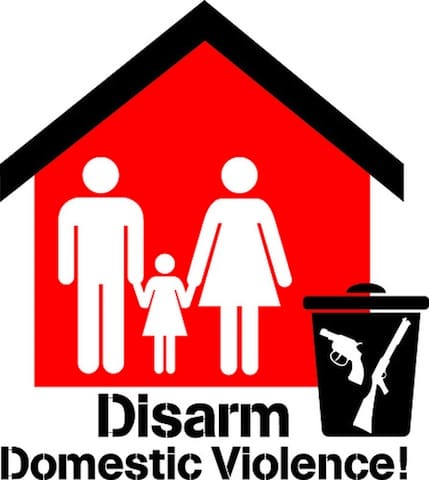Guns and domestic violence are two important topics in my life. Guns are my hobby, a fascinating and enjoyable hobby that I am proud to share with friends and pass on to my children. I deal with domestic violence at work, far more than I want to, and it has been a subject of much of my professional life. A subject that I gratefully leave at the office, due to attorney-client privilege and the fact that my wife (and especially my daughters) don’t need to know quite everything that I know.And I know this: guns and domestic violence are an explosively dangerous combination. Far more dangerous than guns and alcohol, or guns and drugs.
I’ve studied domestic violence from almost every angle (except that of the perpetrator.) I’ve prosecuted batterers, defended them in court, served on the Board of Directors of a women’s shelter, and served as the in-house attorney for another. I was warned by one sociopathic batterer that if I pushed him too far, he’d do a “John Lee Malvo” on my lawyer ass. Despite his menacing reference to the D.C. Beltway sniper, the judge terminated his visitation with his children.
Ms. Slaughter (“Alabama Domestic Violence Educator: Walk Away”) may not have expressed herself artfully, but the lethality risk factors for victims of domestic violence are very real. Violence committed with a weapon, exemplary violence toward children or pets, and suicide or death threats are all strongly correlated with eventual lethality to the victim.
Many victims are economically dependent on their abusive partner, which makes leaving very difficult. Most victims consider leaving, or wait for their chance to leave, for months or even years before actually getting out. Safety for the victim, however, means much more than just ‘getting out,’ because victims typically return to their abusive partner one or more times before finally escaping the relationship for good. Many chronic victims of domestic violence exhibit character traits associated with Dependent Personality Disorder, which compel them to remain with the abuser even in the absence of economic or objectively rational motivations.
The most dangerous domestic abusers are also characterized by Axis II personality disorders: typically Antisocial, Borderline and Narcissistic Personality Disorders. The highest lethality risk factors are associated with Narcissistic abusers who feel an entitlement, based on their perceived inherent superiority, to control and take what they want from others.
What does all this psycho-socio-babble mean to the gun owner? Much.
For one thing, is means that the simplistic response of arming the victims will not work. An armed and aware target of street crime has a much higher chance of escaping or surviving a confrontation with their attacker, and this is why the lawful concealed carry of defensive firearms has gone completely viral in the last few decades.
Arming victims of acute and recent domestic violence, however, is irresponsible and dangerous. The disorganized thinking and vulnerable emotional state of such victims, along with the manipulative skills of the abuser, often mean that any gun in the victim’s vicinity will end up in the hands of the batterer.
What should you do if you know someone who is being abused and controlled by a partner? I know it sounds like limp-wristed advice, but professional counseling for the victim is crucial to ending their cycle of victimization and giving them the emotional and practical skills to escape the relationship. This counseling, and many other invaluable victim services, are available for free in every community in the United States.
The National Domestic Violence Hotline number is 1-800-799-SAFE. Anyone can call this number, at any time of day or night, to be connected to a local program or shelter like the agency I used to serve on. The local DV agency can provide the victim with emergency shelter and support, safety planning, and counseling. They can also assist the victim (and possibly you, if you are sheltering them) with getting a restraining order against the batterer.
If you are providing temporary shelter or respite to a victim of domestic violence, you must understand that your home is now a target zone. An abusive ex-partner may be willing to force entry into your home to regain control of their victim, and may be capable of extreme violence towards the victim, their own children, and anyone (you) who may attempt to intervene.
If the batterer threatens you or your guest, you must seek legal protection through a restraining order in addition to your now-enhanced security planning. Restraining orders don’t stop bullets, but they do bring the police to your home, en masse and with extreme speed, when you call 911 to report a violation in progress.
Until you have a protection order, it’s the batterer’s word against yours. Once you’ve got the protection order, the police will assume that you’re the good guy (or girl) through nearly any tribulations that follow. If you summon them to respond to a confrontation with the restrained party (the batterer), LEO’s suspicion will fall instantly on the batterer and not on you.
This is a good thing, especially in a worst-case scenario where the ‘restrained party’ is bleeding out in your driveway. Even in a much better-case scenario where nobody gets hurt, the odds are excellent that the batterer will go to jail just for coming to your house. Or even calling. Or texting. Or emailing. You get the point.
This is all good news, once the police show up, but sometimes they show up too late to help the unprepared. This is where your enhanced security planning must enter the equation. Regardless of your level of preparation, the security of your home may be severely compromised by the emotional vulnerability of the victim, who may be shamed or cowed into compliance with their abuser’s demands. They may tell him that you’re armed; they may tell them where your guns are kept.
For these reasons, it might be best if she did not know either of these things. They might sneak out to meet him; they might let him into your home in the dead of night. Your security planning must consider this, if you are sheltering a recent victim of domestic violence.
In some circumstances it will be safer for the victim to seek shelter at a secure DV shelter agency. The better-equipped of these shelters have extensive passive and active security systems, including perimeter alarms and hardened man-trap vestibules. They have trained staff who will not allow un-vetted guests onto the premises under any circumstances. If the victim is especially emotionally vulnerable, it may be safer for her and for you if she stays at a secure shelter.
If a loved one is being abused by a spouse or domestic partner, there are helpful actions you can take but there are no simple solutions. The best response is a time-consuming combination of emotional and perhaps economic support from friends and family, professional counseling, legal remedies, and safety planning. If you need to intervene further, use caution.





The Truth Sucks. No easy answers / welcome to the real world.
You are exactly right. Most battered spouses/partners would never use a gun on their abuser. Most committed to their sources/partners already knowing that the SOBs were abusive but they do so anyway because they have the delusion that 1) they are the only one that can fix the abuser, who is really a great guy/gal [*eye roll*], or 2) they somehow deserve being punished. In other words, they are stupid. How could they shoot their misunderstood "project" or "the only person in the world that could possibly love me"? Not only will they not use a gun to defend themselves, but many won't even make the 911 phone call to report a restraining order violation.
Excellent points. Most DV victims are psychologically incapable of defending themselves, and many are incapable of even summoning help. Intervening in a DV altercation is very dangerous. As any cop can tell you, the batterer and the victim frequently join forces to gang up on the Good Samaritan, even when that Samaritan is armed and in uniform. And if the Samaritan isn't a cop, the victim and batterer will frequently fabricate a story which blames the Samaritan for the entire incident. If you're that Samaritan and you don't have backup witnesses, it really sucks to be you.
The helplessness of the chronic DV victim isn't a sign of low native intelligence; rather it is a learned response, typically conditioned and reinforced by months or years of threats, coercion, and calculated violence at the hands of batterers. Once this helpless condition is learned, victims often go from one abusive partner to the next as they try to find an ever-stronger 'protector' figure. These behavioral patterns take months or years to learn, and they also take months or years to unlearn through counseling. It is extremely unusual for a victim to suddenly 'get it' and simply leave an abusive relationship for good.
Mr Dumm, my compliments this is the first time I have read someone who can spout the psychobabble AND give good security/legal advice. Most excellent and interesting.
I have made it a rule never to help a female having problems with someone until they made a written complaint to PD, work, or anyother officialdom, purley to help protect myself. Extremely sad how few females would file such a report. I cannot explain it but it sounds like you have.
Thank you
NukemJim
Comments are closed.